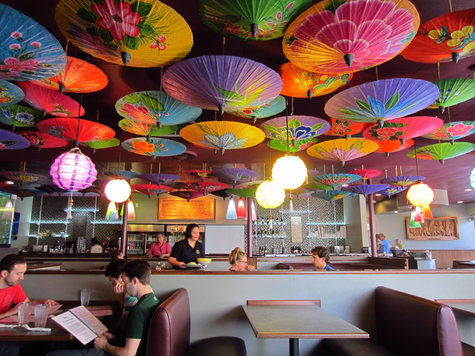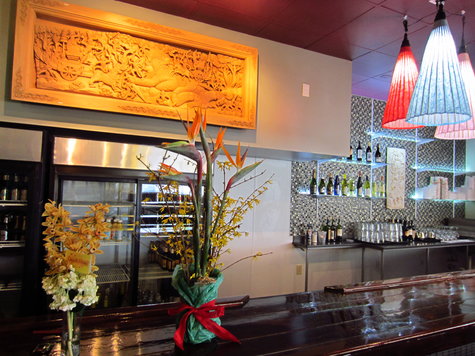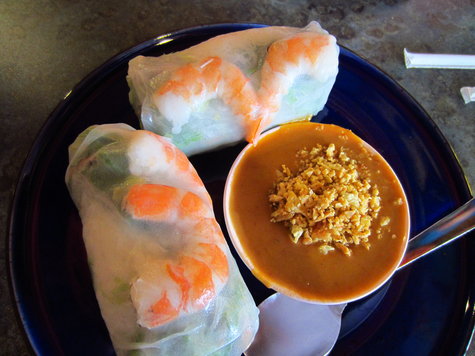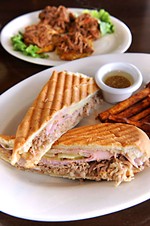First Look at Sap’s Sibling in Allandale
Second location for Austin Thai fave Sap's Fine Thai Cuisine
By Mick Vann, 4:50PM, Mon. Mar. 3, 2014
A couple of weeks ago, I ate at my buddy Sap’s newly opened restaurant. Sap's Fine Thai Cuisine in the southern bend of the Allandale Village, on the southwest corner of Burnet Rd. and RR 2222, just across the street from where the original Frisco Shop stood for decades.

Most of the seating is in comfy over-stuffed booths, with a line of tables running left-center. On the far left side is a separate party room-overflow seating area that can hold up to 60, and Sap doesn't charge for its use. It’s a flexible space, set with tables and chairs.

My dining partner was a bit of a wimp, spice-wise, so the menu choices reflect her semi-aversion to piquant flavors. That fact might prove refreshing for those who are always afraid that Thai food will be too spicy for them. We started with the Fresh Spring Rolls with Shrimp (S-A2), tender rice paper wrappers around a filling of poached shrimp, rice noodles, crispy lettuce, basil, and mint, served with a smooth peanut and tamarind dipping sauce; always a perfect starter, especially on a hot day.

When you go to Thai markets, you see big bags of pristine black and white peppercorns for sale everywhere, and in season at the massive Noen Sung Fruit Market, baskets of crunchy, piquant, emerald green, young peppercorns. The area produces about 75% of the peppercorns in Thailand, and in Thailand the pepper from Chanthaburi is considered the finest available. Tender, garlicky, and with just a little peppery bite, this is a very satisfying dish.
Next up was Sap’s Sweet and Sour (S-P28) and we ordered it with ground pork. When you think of sweet and sour, the immediate image is of Americanized-Chinese thick, gloppy ketchup and vinegar sauce. Thai sweet and sour bears no resemblance to that whatsoever. It has soy and fish sauce, palm sugar and vinegar, tomato paste and chile sauce, lemongrass and Thai lime leaf, and a healthy dose of garlic. The texture of the sauce is more like a velvety soup and the effect is one of lightness, barely coating the ingredients.
The Sweet and Sour comes with chunks of fresh pineapple, onion, cloud ear mushrooms, crunchy green beans, and quartered baby eggplants, perfect with the sweet ground pork. My personal preference is to order it with a little side serving of the incendiary naam jim talay, garlic-green chile sauce that is regularly served with the grilled seafood skewers; it’s a perfect match.
We got one of my old standby’s, Guay Tiew Kua Gai (S-F111), flat sen yai rice noodles stir-fried with ground chicken, egg, bean sprouts, sweet-sour pickled radish, a soy-based mother sauce, and a big salad on the side. I love this dish. It also comes with a clear sweet chile sauce to garnish it, and then I like to add a little Siracha sauce to balance the sweetness.
(Notice I spelled it Siracha instead of Sriracha, like the dreaded Rooster Brand. That’s because Amphoe Si Racha, a seaside district just south of Bangkok and north of Pattaya, near Chonburi, is where the THAI fermented chile sauce originated. The Thai chile version, from Si Racha, is infinitely better than the jalapeño version made in south L.A. by the Vietnamese Rooster Brand. Word-up: if you ever see the rare yellow Thai chile version of Si Racha sauce for sale in any Asian market, grab it and cherish every drop of its spicy lusciousness. You can find it in Thailand, but seldom over here.)
Last was the magnificent Seua Rong Hai or Tiger Cry (S-P48). This is an Isaan dish of sliced, marinated grilled meat accompanied by a spicy Jaew dipping sauce. It can be eaten as a salad (but not to my way of thinking) or as an entrée, and is very popular in Thailand as a snack to accompany cold beers or shots of whiskey. When you see this dish offered in American Thai restaurants cooked as a stir-fry, you can be assured that it is not an authentic preparation. In less chile-tolerant America, this old traditional dish has taken on a new meaning as being a “dish so hot that it makes even a tiger cry,” but that is far from the original translation of the dish in Thailand, where seua means “tiger” and rong hai means “crying”.
Originally, the dish was made using only meat from water buffalo that had gotten too old to continue working the fields. A water buffalo is too valuable as a farm work animal in the rice paddies to be raised merely for food; they are only eaten after having lost their ability to contribute. In Thailand, the dish came to be known as “tiger cry” because meat from the older water buffalo was so tough and hard to chew that even tigers would cry if they ate it.
Although water buffalo meat is still eaten in Thailand, especially in poorer outlying districts, the growth of the Thai beef cattle industry and the importation of beef from Australia, the U.S., and South America has made high quality affordable beef available nationwide there now.
Thankfully, the Tiger Cry cooked at Sap’s is a misnomer; it is remarkably tender, and spicy, but not intolerably so. Sap’s kitchen uses high quality sirloin steak, marinated simply in garlic, soy, and fish sauce. The beef is char-grilled to medium-rare, rested, and sliced thinly against the grain, yielding delicious, juicy, smoky, fork-tender steak strips.
These slices are wrapped with romaine lettuce leaves and red onion, and dipped into a thin jaew sauce made of lime, lemongrass, fish sauce, soy, dried roasted chile, scallion, and cilantro, thickened slightly with nutty ground roasted rice, with just a touch of palm sugar to give a little balance to the citrus. This particular sauce is like crack for char-grilled meat. The sticky rice is eaten with the fingers, shaping it into little footballs, to soak up the succulent meat juices. The flavor of Tiger Cry is extraordinary and it’s so tender it melts in your mouth; it's one of the best meat dishes on the menu. We ended up fighting over that last bite. A glass of water and a pot of ginger tea with a little brown sugar and we were completely satiated, happy as can be.
Sap’s new outlet is superb, and a delight for the eyes and the palate. What was once a funky spot on the wrong end of the strip mall has been magically transformed into a temple of Thai cuisine, and in my estimation, should soon become a new anchor for the strip. Go there, you won’t be disappointed.
Sap’s Fine Thai Cuisine
5800 Burnet Rd (in Allandale Village) 512/419-7244
A note to readers: Bold and uncensored, The Austin Chronicle has been Austin’s independent news source for over 40 years, expressing the community’s political and environmental concerns and supporting its active cultural scene. Now more than ever, we need your support to continue supplying Austin with independent, free press. If real news is important to you, please consider making a donation of $5, $10 or whatever you can afford, to help keep our journalism on stands.
Virginia B. Wood, Aug. 14, 2014
Virginia B. Wood, March 23, 2014
restaurant opening, Sap's Fine Thai Cuisine, Sapachai Apisaksiri, Thai Food, Thai Pepper, Siracha sauce, Sriracha sauce, Allendale Village










